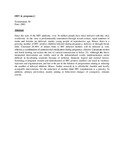| dc.description.abstract | Since the start of the HIV epidemic, over 36 million people have been infected with the virus worldwide. As the virus is predominantly transmitted through sexual contact, equal numbers of males and females are infected, mainly young people of reproductive age. Hence, there is a growing number of HIV positive children infected during pregnancy, delivery or through breastmilk. Untreated 20-40% of infants born to HIV infected mothers will be infected as well, whereas a combination of antiretroviral medication during pregnancy, elective Caesarean section and bottle feeding can reduce the risk of vertical transmission to below 2%. Although the above mentioned intervention are widely used in the industrialised world, implementation seems difficult in developing countries because of political, financial, logical and societal factors. Screening of pregnant women and identification of HIV positive mothers can result in violence, rejection and stigmatization, and has to be put in the balance of programmes aiming at reducing the number of infected children. Hence, further research in to affordable, feasible and locally acceptable interventions for the reduction of mother-child HIV transmission is a priority. In addition, primary prevention, mainly aiming at behavioural changes of youngsters, remains crucial | en |

